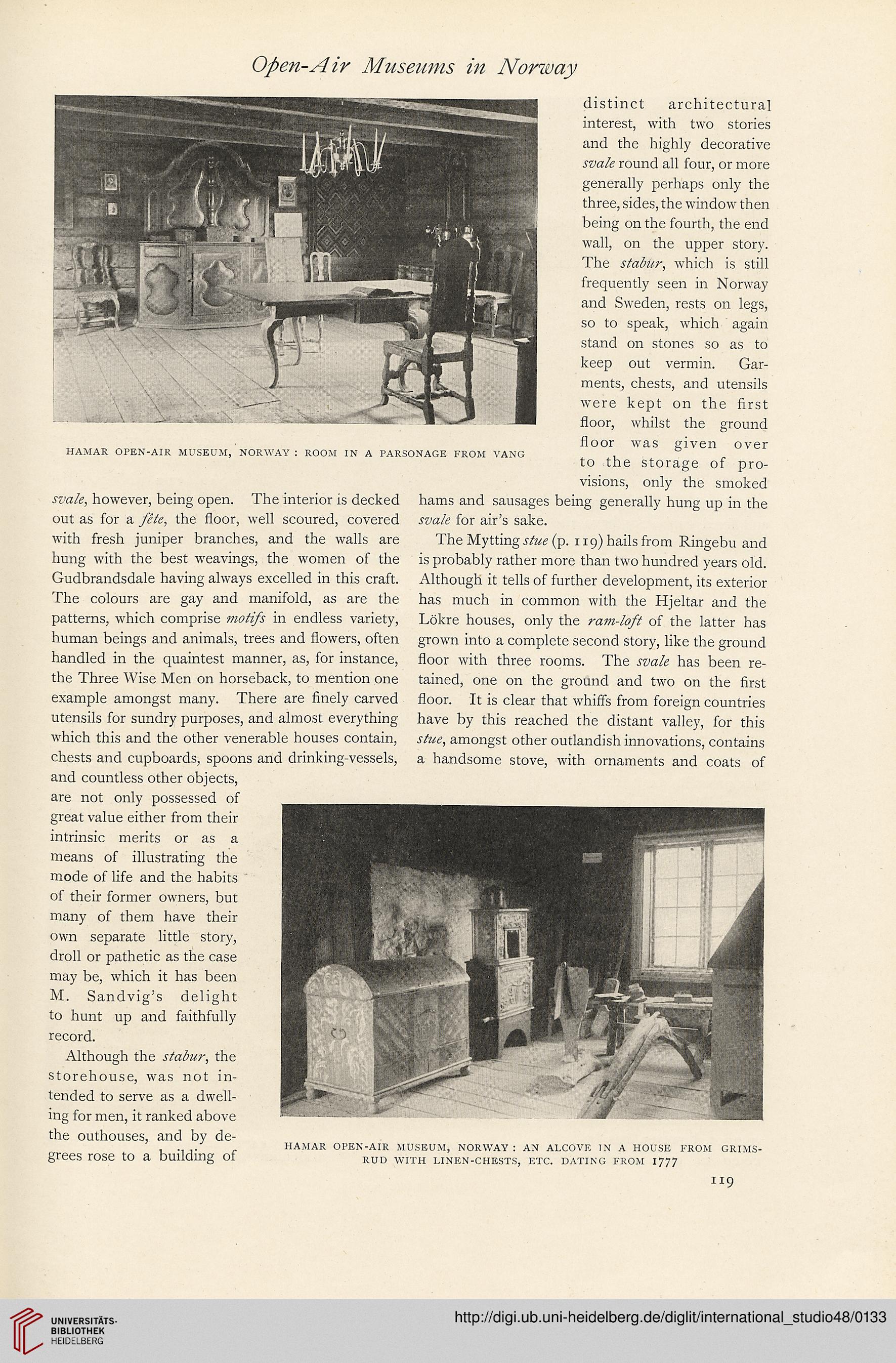Open-Air Museums in Norway
HAMAR OPEN-AIR MUSEUM, NORWAY : ROOM IN A PARSONAGE FROM VANG
svale, however, being open. The interior is decked
out as for a fete, the floor, well scoured, covered
with fresh juniper branches, and the walls are
hung with the best weavings, the women of the
Gudbrandsdale having always excelled in this craft.
The colours are gay and manifold, as are the
patterns, which comprise motifs in endless variety,
human beings and animals, trees and flowers, often
handled in the quaintest manner, as, for instance,
the Three Wise Men on horseback, to mention one
example amongst many. There are finely carved
utensils for sundry purposes, and almost everything
which this and the other venerable houses contain,
chests and cupboards, spoons and drinking-vessels,
and countless other objects,
are not only possessed of
great value either from their
intrinsic merits or as a
means of illustrating the
mode of life and the habits
of their former owners, but
many of them have their
own separate little story,
droll or pathetic as the case
may be, which it has been
M. Sandvig’s delight
to hunt up and faithfully
record.
Although the stabur, the
storehouse, was not in-
tended to serve as a dwell-
ing for men, it ranked above
the outhouses, and by de-
grees rose to a building of
distinct architectural
interest, with two stories
and the highly decorative
svale round all four, or more
generally perhaps only the
three, sides, the window then
being on the fourth, the end
wall, on the upper story.
The stabur, which is still
frequently seen in Norway
and Sweden, rests on legs,
so to speak, which again
stand on stones so as to
keep out vermin. Gar-
ments, chests, and utensils
were kept on the first
floor, whilst the ground
floor was given over
to the storage of pro-
visions, only the smoked
hams and sausages being generally hung up in the
svale for air’s sake.
The Mytting stue (p. 119) hails from Ringebu and
is probably rather more than two hundred years old.
Although it tells of further development, its exterior
has much in common with the Hjeltar and the
Lokre houses, only the ram-loft of the latter has
grown into a complete second story, like the ground
floor with three rooms. The svale has been re-
tained, one on the ground and two on the first
floor. It is clear that whiffs from foreign countries
have by this reached the distant valley, for this
stue, amongst other outlandish innovations, contains
a handsome stove, with ornaments and coats of
HAMAR OPEN-AIR MUSEUM, NORWAY : AN ALCOVE IN A HOUSE FROM GRIMS-
RUD WITH LINEN-CHESTS, ETC. DATING FROM
119
HAMAR OPEN-AIR MUSEUM, NORWAY : ROOM IN A PARSONAGE FROM VANG
svale, however, being open. The interior is decked
out as for a fete, the floor, well scoured, covered
with fresh juniper branches, and the walls are
hung with the best weavings, the women of the
Gudbrandsdale having always excelled in this craft.
The colours are gay and manifold, as are the
patterns, which comprise motifs in endless variety,
human beings and animals, trees and flowers, often
handled in the quaintest manner, as, for instance,
the Three Wise Men on horseback, to mention one
example amongst many. There are finely carved
utensils for sundry purposes, and almost everything
which this and the other venerable houses contain,
chests and cupboards, spoons and drinking-vessels,
and countless other objects,
are not only possessed of
great value either from their
intrinsic merits or as a
means of illustrating the
mode of life and the habits
of their former owners, but
many of them have their
own separate little story,
droll or pathetic as the case
may be, which it has been
M. Sandvig’s delight
to hunt up and faithfully
record.
Although the stabur, the
storehouse, was not in-
tended to serve as a dwell-
ing for men, it ranked above
the outhouses, and by de-
grees rose to a building of
distinct architectural
interest, with two stories
and the highly decorative
svale round all four, or more
generally perhaps only the
three, sides, the window then
being on the fourth, the end
wall, on the upper story.
The stabur, which is still
frequently seen in Norway
and Sweden, rests on legs,
so to speak, which again
stand on stones so as to
keep out vermin. Gar-
ments, chests, and utensils
were kept on the first
floor, whilst the ground
floor was given over
to the storage of pro-
visions, only the smoked
hams and sausages being generally hung up in the
svale for air’s sake.
The Mytting stue (p. 119) hails from Ringebu and
is probably rather more than two hundred years old.
Although it tells of further development, its exterior
has much in common with the Hjeltar and the
Lokre houses, only the ram-loft of the latter has
grown into a complete second story, like the ground
floor with three rooms. The svale has been re-
tained, one on the ground and two on the first
floor. It is clear that whiffs from foreign countries
have by this reached the distant valley, for this
stue, amongst other outlandish innovations, contains
a handsome stove, with ornaments and coats of
HAMAR OPEN-AIR MUSEUM, NORWAY : AN ALCOVE IN A HOUSE FROM GRIMS-
RUD WITH LINEN-CHESTS, ETC. DATING FROM
119




